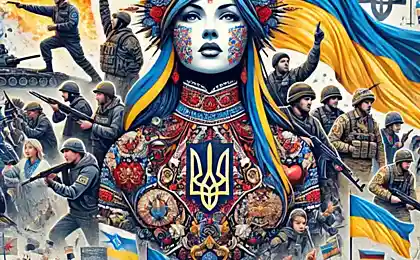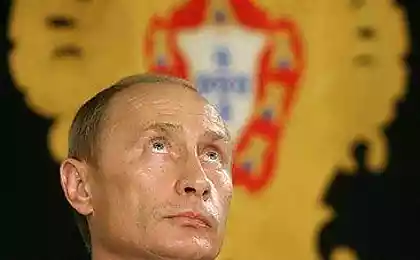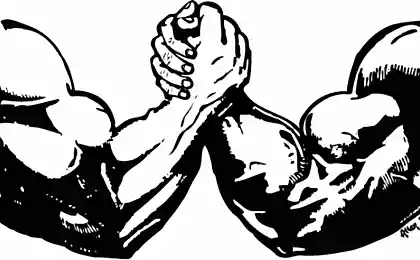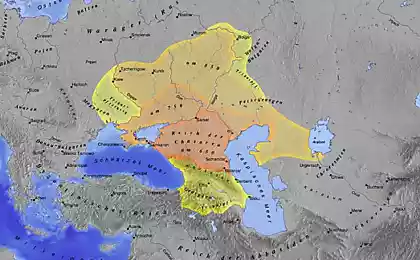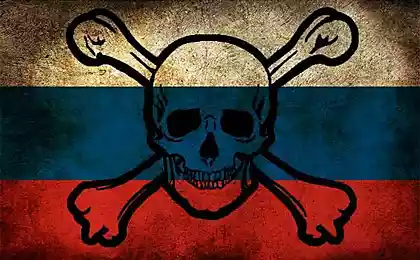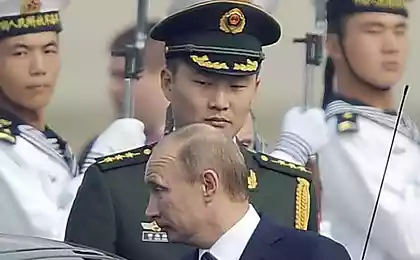1654
Crimean collaborators
... The Russian media like to make noise about "aiding the Nazis Bandera", hiding the scale Collaboration in the Crimea, including Sevastopol, in the period of the German-Romanian occupation. Today, this period of time is still a mystery of mysteries.
But not everything was so simple. If in the western regions of Ukraine in the defense of his people against the Nazi aggressors was the UPA, in the south-eastern regions and in Crimea, it was more difficult - on the contrary, to help the occupiers began to oppress the native people legions of collaborators. Since the mid summer of 1942 they went under the same banner under which now goes Russian community were the same shape that are present Crimean Russian Cossacks.
And they all said, among other things, in Russian. The vast majority of German accomplices - formations Russian Liberation Army (ROA) in the territory of Crimea and Ukraine were mostly made of Russian-speaking collaborators.
And if the Ukrainian battalions "Roland" and "Nachtigall" are a favorite theme of the Russian media, it is time to tell you about homegrown Crimean kazachkah, whose descendants today in a row in the service of the Moscow as "fighters against fascism", and really struggling exclusively Ukrainian state. Even on the day of the celebration of the Great Victory over Nazism May 9, under the flags of ROA love to walk the streets of Sevastopol and demonstrate that "in the city of Russian glory" there is no limit to cynicism.
Archives and statistics, and documentary research of many Russian writers packed dry eloquent facts.
So, Crimea put only 11 th German Army Manstein 45,000 (!) Bayonets, which took part in the storming of Sevastopol.
In the 17 th Army Wehrmacht was formed nine separate Russian mouth.
Crimean "volunteers", in contrast to the UPA, which protected their land, took part in the siege of Leningrad. Crimean Tatars, among other things, to "Wehrmacht" did not take, so here the thesis of "Crimean Tatar traitors" to hide.
Modern Crimean "fighters against fascism" that is not in a hurry to tell the residents of the Crimea, as of someone in Simferopol in February 1942 formed the 5th Simferopol Cossack Cossack Cavalry Squadron "Background Yungshultsa" and 1st St. Andrew hundred near Simferopol.
Also from the Russian Germans formed on the peninsula four Russian Cossack battalion, which became the basis of Russian Cossack Security Division "von Schulenburg." This division was finally destroyed it in battles with the UPA in 1944.
In February 1942, in Simferopol headquarters 11 th Army Wehrmacht was formed 5 th Simferopol Reitarska Cossack squadron, based on which was established Cossack regiment Reitarska commanded by Lieutenant Colonel von Schulze 1 Panzer Army. In 1943, the regiment was one of the best in the fight against the Red Army and the guerrillas was included in the 1st Cossack Cavalry Division of the Waffen SS, and subsequently expanded and was transformed into the 15th Cossack Corps of the Waffen SS.
It should be noted that Hitler was included in Crimea Reyhkomisariat "Ukraine". Therefore, it is 15 th SS Cossack Corps, formed in the Crimea, not the SS Division "Galicia" was the first in Ukraine collaborationist union, fully included in the Waffen-SS.
Body - not division, and still much more. Therefore, Lviv with its Division "Galicia" and two battalions that have not sworn allegiance to the Fuhrer and Reich and most moved to the UPA, oh, how far up the Crimean Kazatchkov.
In addition to the above facts, the inhabitants of Crimea were formed by three Russian marching battalion of the Wehrmacht, 560- and 994 th th field battalions ROA.
Besides Cossack Corps, first in Sevastopol, and then in Simferopol were doukomlektovany staff, management, and two battalions of the 1st Grenadier Division of the SS "Russia" and initiated the formation of the 2nd Division.
Of people and prisoners of war in Sevastopol was formed 381 th Sevastopol teaching and Field Division of the Wehrmacht.
Coastal defenses from Sevastopol to Feodosiya during 1942-1944 provided the command "Kringsmarine the Black Sea," in which officers were Germans, and soldiers - Russian exclusively recruited from the local population and prisoners of war. Although these "kringsmarintsy" at the approach of the Red Army shot their officers and went to the partisans - yet two years they have served the invaders.
Separately, it should be said about the Crimean police battalions - the so-called "HіVі" ("Volunteers" - the Nazis, of course). In Sevastopol, a battalion was formed out of 450 local residents and guarded seaport, and in Crimea such as "helpers" blocked the Soviet partisans in the mountain forests.
If we compare the number of collaborators of the Crimea and Western Ukraine in their relation to the number of local people in 1941, it produced some interesting results. In the western regions of Ukraine the number of collaborators that have fallen in the service of the occupiers (even including a common list of Ukrainian Division "Galicia" and battalions "Roland" and "Nachtigall") is about 2, 5% of the total number of people in the region. In Crimea - nearly 12% ...
Today in the Crimea again henchmen are new Hitler - from Moscow. Only now they are not fighting against the Soviet and against the Ukrainian government. And at the same time against the Ukrainian people, who do not even know how to properly speak Ukrainian.
Source npubop.livejournal.com/
But not everything was so simple. If in the western regions of Ukraine in the defense of his people against the Nazi aggressors was the UPA, in the south-eastern regions and in Crimea, it was more difficult - on the contrary, to help the occupiers began to oppress the native people legions of collaborators. Since the mid summer of 1942 they went under the same banner under which now goes Russian community were the same shape that are present Crimean Russian Cossacks.
And they all said, among other things, in Russian. The vast majority of German accomplices - formations Russian Liberation Army (ROA) in the territory of Crimea and Ukraine were mostly made of Russian-speaking collaborators.
And if the Ukrainian battalions "Roland" and "Nachtigall" are a favorite theme of the Russian media, it is time to tell you about homegrown Crimean kazachkah, whose descendants today in a row in the service of the Moscow as "fighters against fascism", and really struggling exclusively Ukrainian state. Even on the day of the celebration of the Great Victory over Nazism May 9, under the flags of ROA love to walk the streets of Sevastopol and demonstrate that "in the city of Russian glory" there is no limit to cynicism.
Archives and statistics, and documentary research of many Russian writers packed dry eloquent facts.
So, Crimea put only 11 th German Army Manstein 45,000 (!) Bayonets, which took part in the storming of Sevastopol.
In the 17 th Army Wehrmacht was formed nine separate Russian mouth.
Crimean "volunteers", in contrast to the UPA, which protected their land, took part in the siege of Leningrad. Crimean Tatars, among other things, to "Wehrmacht" did not take, so here the thesis of "Crimean Tatar traitors" to hide.
Modern Crimean "fighters against fascism" that is not in a hurry to tell the residents of the Crimea, as of someone in Simferopol in February 1942 formed the 5th Simferopol Cossack Cossack Cavalry Squadron "Background Yungshultsa" and 1st St. Andrew hundred near Simferopol.
Also from the Russian Germans formed on the peninsula four Russian Cossack battalion, which became the basis of Russian Cossack Security Division "von Schulenburg." This division was finally destroyed it in battles with the UPA in 1944.
In February 1942, in Simferopol headquarters 11 th Army Wehrmacht was formed 5 th Simferopol Reitarska Cossack squadron, based on which was established Cossack regiment Reitarska commanded by Lieutenant Colonel von Schulze 1 Panzer Army. In 1943, the regiment was one of the best in the fight against the Red Army and the guerrillas was included in the 1st Cossack Cavalry Division of the Waffen SS, and subsequently expanded and was transformed into the 15th Cossack Corps of the Waffen SS.
It should be noted that Hitler was included in Crimea Reyhkomisariat "Ukraine". Therefore, it is 15 th SS Cossack Corps, formed in the Crimea, not the SS Division "Galicia" was the first in Ukraine collaborationist union, fully included in the Waffen-SS.
Body - not division, and still much more. Therefore, Lviv with its Division "Galicia" and two battalions that have not sworn allegiance to the Fuhrer and Reich and most moved to the UPA, oh, how far up the Crimean Kazatchkov.
In addition to the above facts, the inhabitants of Crimea were formed by three Russian marching battalion of the Wehrmacht, 560- and 994 th th field battalions ROA.
Besides Cossack Corps, first in Sevastopol, and then in Simferopol were doukomlektovany staff, management, and two battalions of the 1st Grenadier Division of the SS "Russia" and initiated the formation of the 2nd Division.
Of people and prisoners of war in Sevastopol was formed 381 th Sevastopol teaching and Field Division of the Wehrmacht.
Coastal defenses from Sevastopol to Feodosiya during 1942-1944 provided the command "Kringsmarine the Black Sea," in which officers were Germans, and soldiers - Russian exclusively recruited from the local population and prisoners of war. Although these "kringsmarintsy" at the approach of the Red Army shot their officers and went to the partisans - yet two years they have served the invaders.
Separately, it should be said about the Crimean police battalions - the so-called "HіVі" ("Volunteers" - the Nazis, of course). In Sevastopol, a battalion was formed out of 450 local residents and guarded seaport, and in Crimea such as "helpers" blocked the Soviet partisans in the mountain forests.
If we compare the number of collaborators of the Crimea and Western Ukraine in their relation to the number of local people in 1941, it produced some interesting results. In the western regions of Ukraine the number of collaborators that have fallen in the service of the occupiers (even including a common list of Ukrainian Division "Galicia" and battalions "Roland" and "Nachtigall") is about 2, 5% of the total number of people in the region. In Crimea - nearly 12% ...
Today in the Crimea again henchmen are new Hitler - from Moscow. Only now they are not fighting against the Soviet and against the Ukrainian government. And at the same time against the Ukrainian people, who do not even know how to properly speak Ukrainian.
Source npubop.livejournal.com/

